Vegetable Recipes for Baby
- Baby
-
- UPDATED NOVEMBER 05, 2024
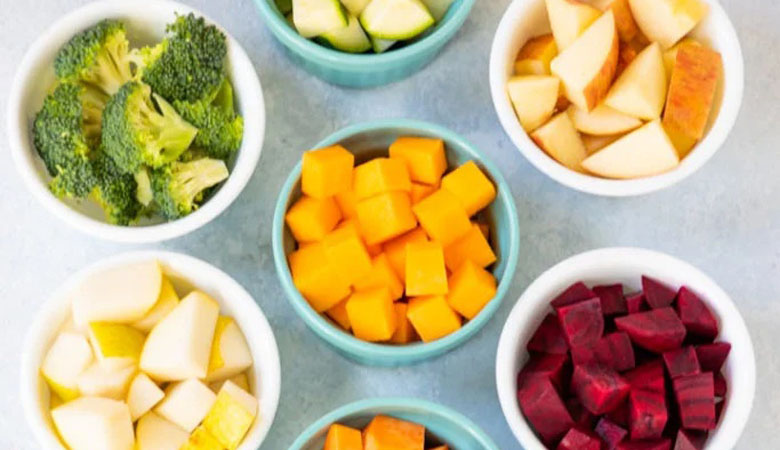
by Tasha Mayberry
630 shares
When it comes to the diet and health of your baby, you will be bombarded with information and recommendations from everyone around, especially when you are about to start solids for your little one. As a mum, you might find it hard, overwhelming, and confusing having to first learn about the different foods you can start for your baby, proper recipes, and also quantity, all while also making sure that the foods you choose add sufficient nutritional value to his/her diet.
Yes, it all sounds daunting; but, trust us, you will get the hang of it!
Regardless of what you learn from books and hear from friends and family, one thing that no one will contradict or deny is adding vegetables to your baby’s diet. Of course, we all know that vegetables are healthy (duh!); but, not many are aware that making vegetables a part of their regular meal right from when infants start solids increases the likelihood that vegetables will be accepted throughout childhood, which is exactly what every parent aims at.
So, if your baby is currently in the transition stage, we have some easy-to-prepare, highly nutritional vegetable recipes for baby that you should try, before you introduce them to their high chair. These recipes are ideal for babies between 6 and 11 months of age.
Before we move on to the actual recipes, here are a few pointers to keep in mind while preparing food for your baby:
- If you are just introducing solids to your little one, start with single vegetable purees before combining two or more.
- When preparing vegetable purees, you can use breast milk, formula milk, or warm water to achieve desired consistency.
- In the case of vegetables, steaming is the most preferred and recommended cooking method, rather than boiling or pressure cooking, as this enables the veggies to retain most of their nutrients.
- Avoid using sugar or salt in your baby’s food at least until he/she is a year old.
- While you can freeze some vegetable purees, it is best to serve them fresh and warm.
- For older babies, you can use a fork or potato masher to mash the cooked vegetables instead of blending them.
- If you are using formula milk to a recipe, remember not to cook the milk along with the vegetable. Just use the milk while blending to reach desired consistency.
Butternut Squash Puree
Ingredients
- 1 butternut squash
- 2 tablespoons olive oil
- A dash of your baby’s regular milk or water
Steps
- Cut the butternut squash and scoop out all the seeds.
- Make a few cuts on the flesh of the squash for even cooking.
- Place the cut quash skin-side down on a baking tray, drizzle some olive oil, and cover the tray with aluminum foil.
- Let it cook in a pre-heated oven for 45 minutes at 180oC.
- Once done, let it cool completely, and then scoop the flesh of the squash and blend the same with a dash of milk or water to achieve your desired consistency.
Sweet Potato Puree
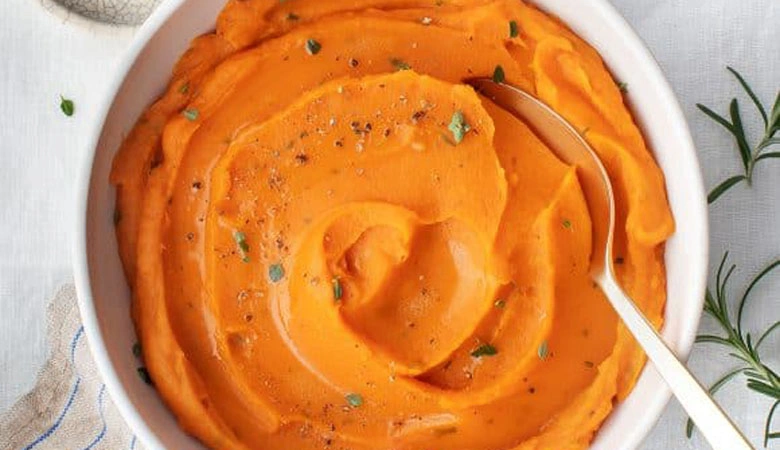
Ingredients
- 1 medium sized sweet potato
- A dash of your baby’s regular milk or water
Steps
- Peel and cut the sweet potato into cubes.
- Place the cubes in a pot of water and let it simmer, covered, until it becomes tender, which could take around 20 minutes.
- Drain the water, and boil the sweet potato adding a little milk or water.
You can also add a few basil leaves in this recipe; just add them to the blender while pureeing the cooked sweet potato
Carrot Puree
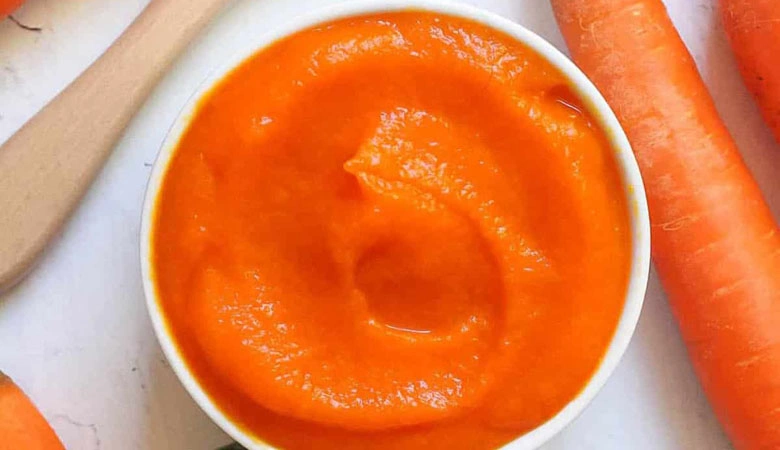
Ingredients
- 1 medium sized carrot
- A dash of your baby’s regular milk or water
Steps
- Wash, peel, and cut the carrot into chunks.
- You can either steam the carrot or boil it. Regardless of which cooking method you choose, make sure it is cooked completely.
- Cool it down after cooking, and blend it with a little milk or water to make a smooth puree.
Carrot is an absolutely versatile vegetable and can be used with many other vegetables to make baby food. You can also add beetroot, potato, or butternut squash along with carrot in this recipe to make the puree.
Avocado and Mint Puree
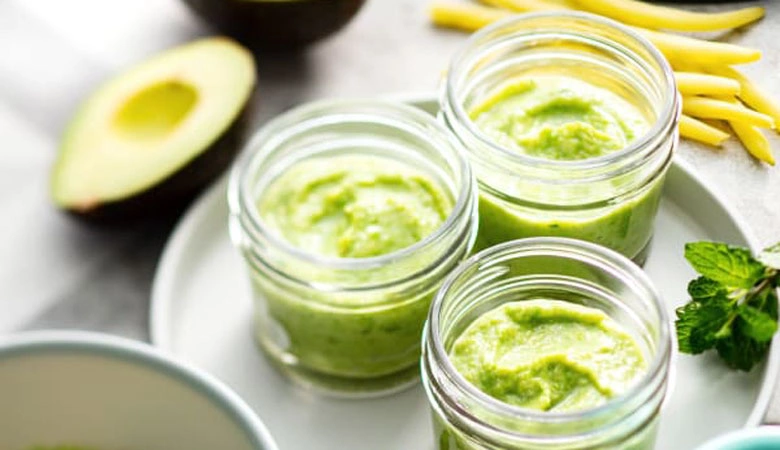
Ingredients
- 1 large, ripe avocado
- 5 to 6 mint leaves
Steps
- Slice the avocado and remove the stone from inside.
- Use a spoon and scoop the flesh from the skin.
- Transfer the flesh to a blender along with chopped mint leaves and blend until smooth.
- For older babies, you can mash the avocado with a fork or masher and mix the chopped mint to it. This can also be serves as a dip with any type of toasted bread for older babies
Cheesy Cauliflower and Broccoli Mash
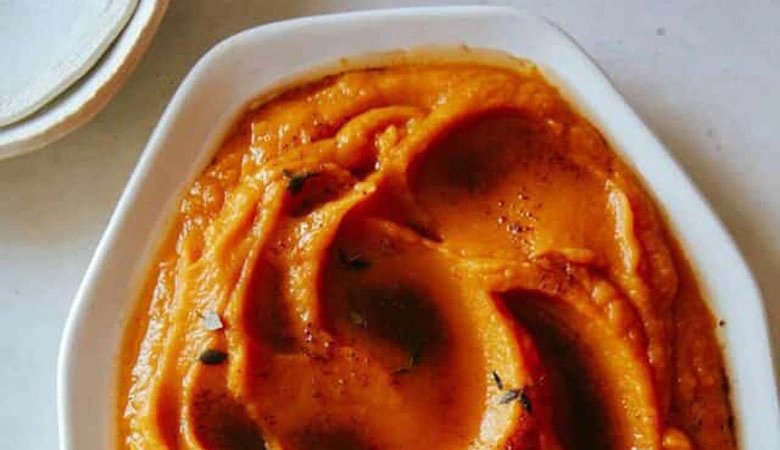
Ingredients
- 100g cauliflower
- 100g broccoli
- 50g grated cheddar or mozzarella cheese
- 6 oz. milk
Steps
- Cut florets from cauliflower and broccoli, and remove any thick stems.
- Add the milk to a sauce pan, add the cut vegetables to the milk, and bring it to a boil.
- Once the milk starts boiling, reduce the flame and simmer the content until the cauliflower and broccoli become tender. This should take around 15 minutes.
- Take the pan off the heat and stir in the cheese until it gets melted. You can also add a little pepper at this point, if you have already introduced it to your baby.
- Mash everything together until the mixture reaches your desired consistency.
Steamed Greens Puree

Ingredients
- 1 cup tightly packed spinach, collard greens, or kale
Steps
- Wash the greens thoroughly and remove any thick stem.
- You can either use a steamer to steam the greens until soft, or immerse them in a pan with water to cook.
- Once cooked, remove them from the steamer, or drain the water, and allow them to cool completely.
- Blend the greens to form a smooth puree. Add a dash of water if required while blending.
Introducing solids to your baby in the form of vegetables is a great way to make them familiar with healthy and nutritious foods. Take your time to determine if your baby has allergies to specific veggies or other ingredients, by introducing one vegetable at a time.